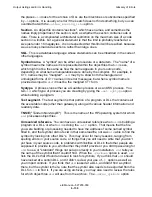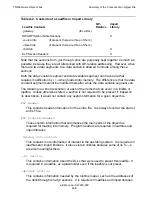
TNS/E Native Object Files
eld Manual—527255-009
A-2
Types of TNS/E Object Files
Types of TNS/E Object Files
There are the following four types of TNS/E object files.
Collectively, programs and DLLs are called loadfiles. Loadfiles and import libraries are
built by the linker.
This appendix describes all four types of object files. The main distinctions occur
between linkfiles and loadfiles. There is little difference between a program and a DLL
as far as the file format is concerned, and an import library is a subset of what is in a
DLL.
A loadfile may refer by name to symbols that exist in other loadfiles in the same
process. Such references are resolved when the loadfiles are brought into memory by
the runtime loader, which is named
rld
, or by the runtime procedure named
dlopen
.
When the loadfile was originally built by the linker it is also possible that the linker tried
to resolve such references. A loadfile whose references have been resolved by the
linker is said to be preset.
A process can also use one user library. A user library is a DLL. Nothing within a user
library distinguishes it from other DLLs, and a DLL that serves as the user library for
one program can also be used like any other DLL by other programs. The only
difference between the user library and other DLLs is in the way the program identifies
the user library that it uses. For a DLL to be used as a user library at runtime its
filename must be in the Guardian namespace.
An import library can take the place of a DLL at link time. One use of import libraries is
to save space. Another use is for security, when it is necessary for the linker to read
the header information but it is not desirable for others to be able to see the code.
Import libraries are further categorized as complete or incomplete. The difference is
that an incomplete import library need not contain the correct addresses for symbols.
A complete import library can be used by the linker when presetting a loadfile. The
Table A-1. Types of TNS/E Object Files
Type of Object File
Description
Linkfile
This is the term for the object files that are produced by a compiler
or by the assembler, and can be given as input to the linker. It is
also possible for the linker to produce a linkfile as output when run
with the
-r
option.
Program
This is the term for a main program. There is one program in
every process.
DLL
This stands for dynamic-link library. It is an object file that is not a
program but can also be part of a process. A process can contain
any number of DLLs. DLLs are also used by the linker when
building other programs or DLLs.
Import Library
This is a file that contains just the part of a DLL that is needed at
link time to build other programs or DLLs.
Summary of Contents for eld
Page 4: ......
Page 8: ...Contents eld Manual 527255 009 iv ...
Page 12: ...What s New in This Manual eld Manual 527255 009 viii Changes to the 527255 005 Manual ...
Page 34: ...Introduction to eld eld Manual 527255 009 1 14 Example of Use ...
Page 54: ...eld Input and Output eld Manual 527255 009 2 20 Using Archives ...
Page 98: ...Other eld Processing eld Manual 527255 009 4 20 Merging Source RTDUs ...
Page 242: ...Output Listings and Error Handling eld Manual 527255 009 6 132 Glossary of Errors ...
















































